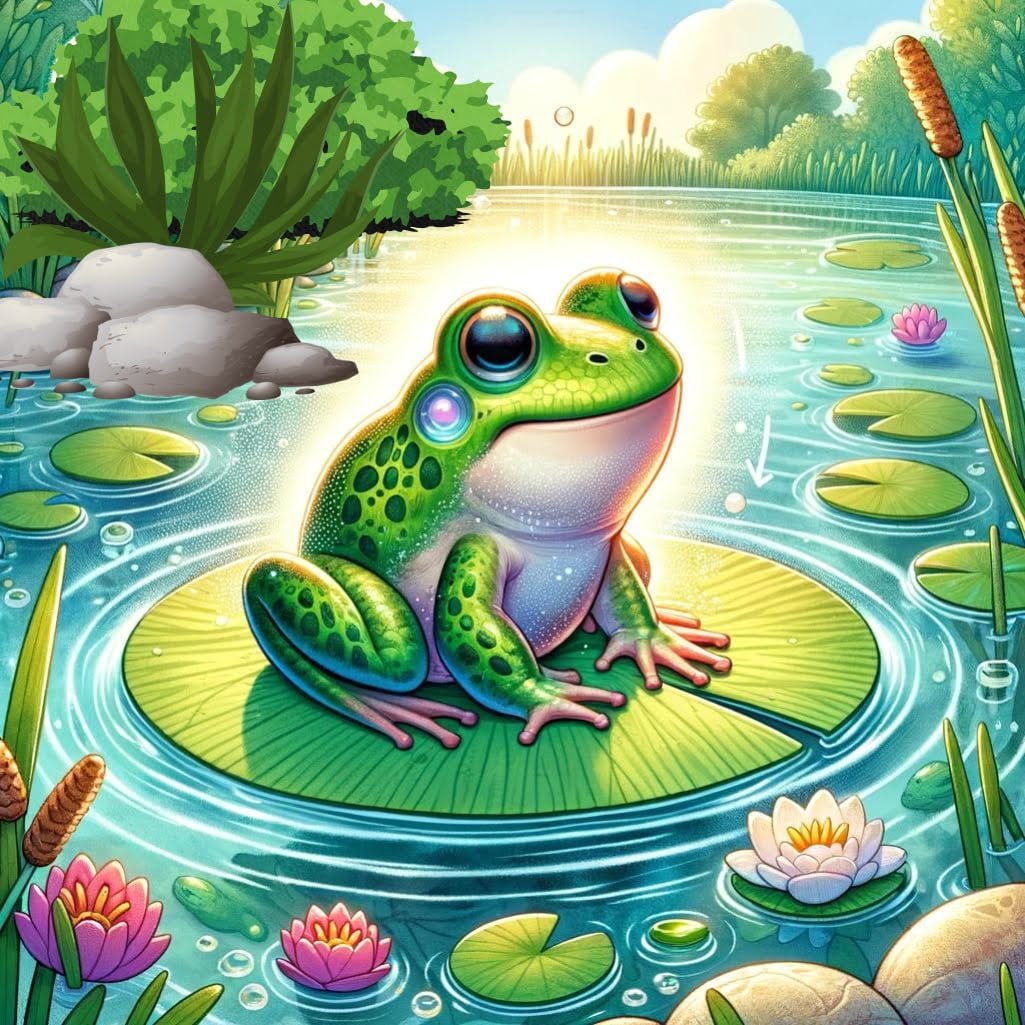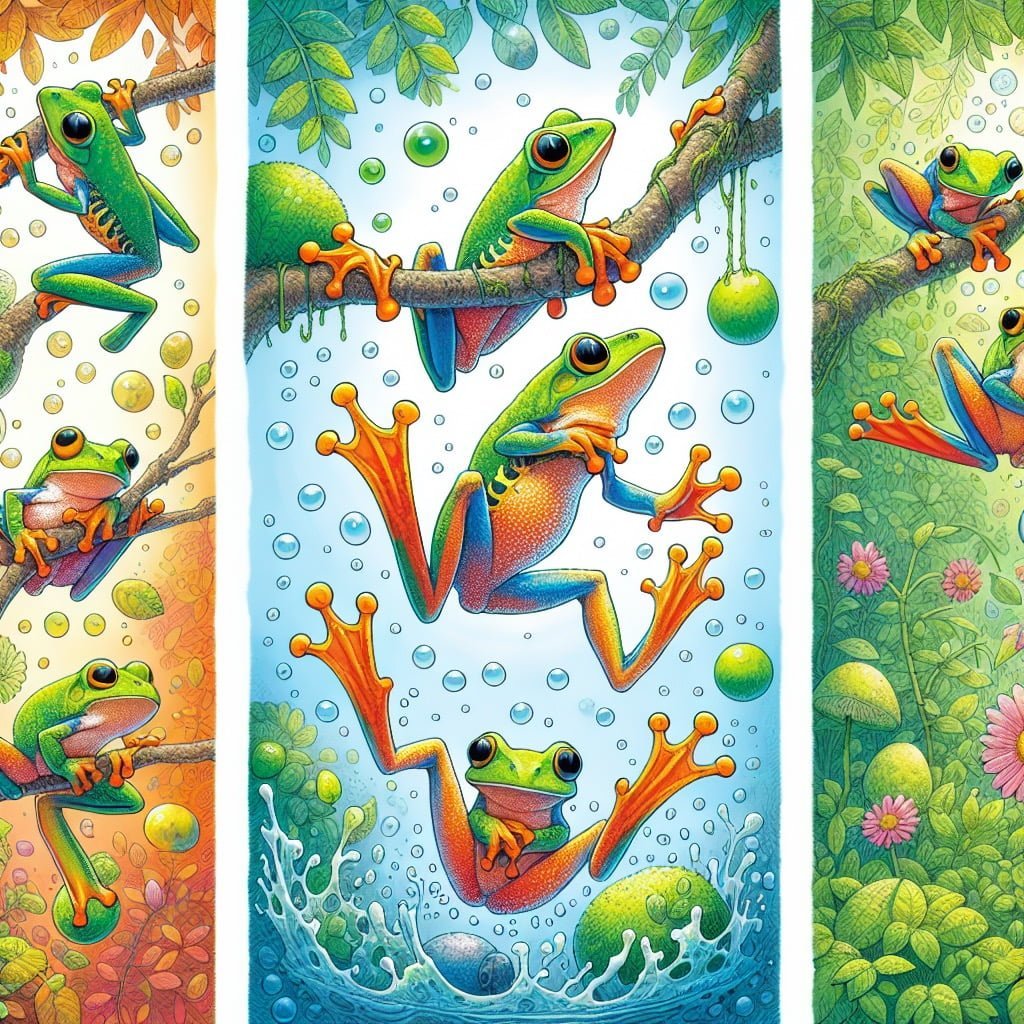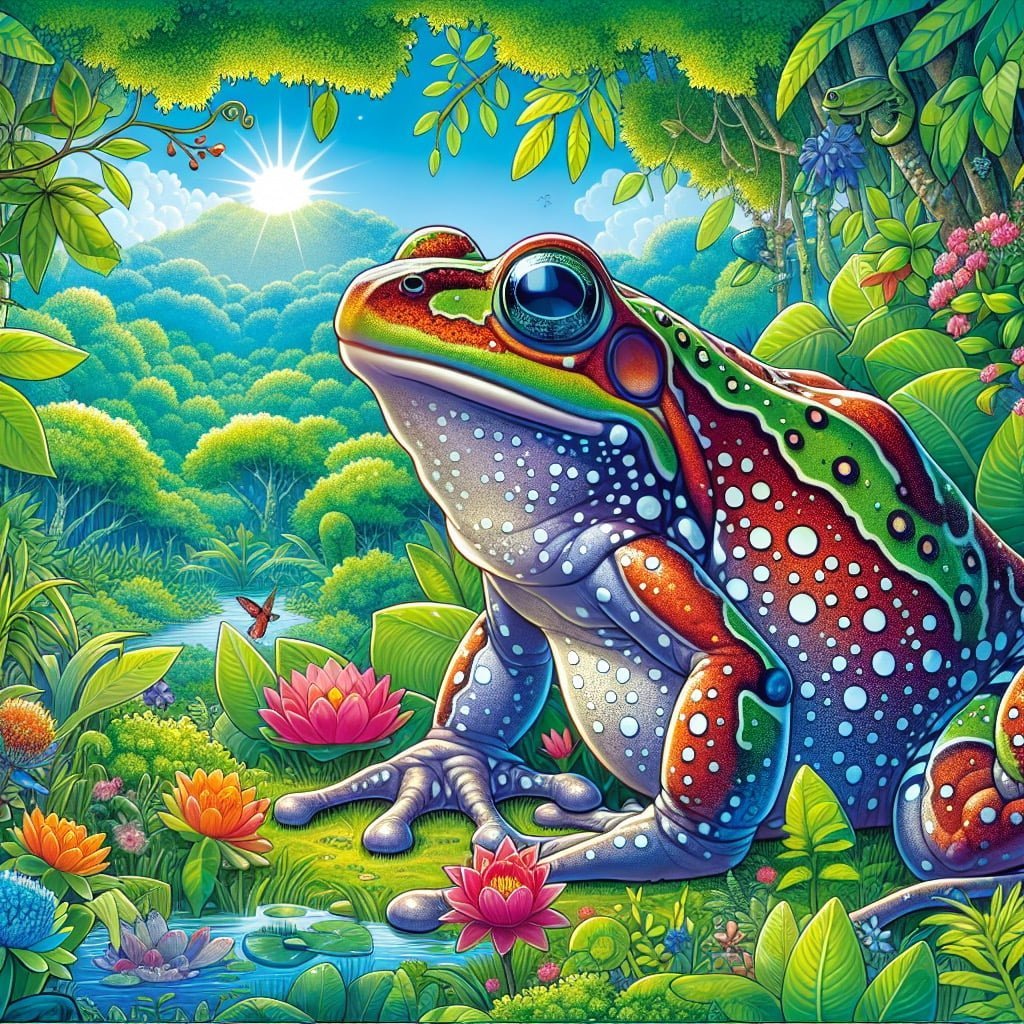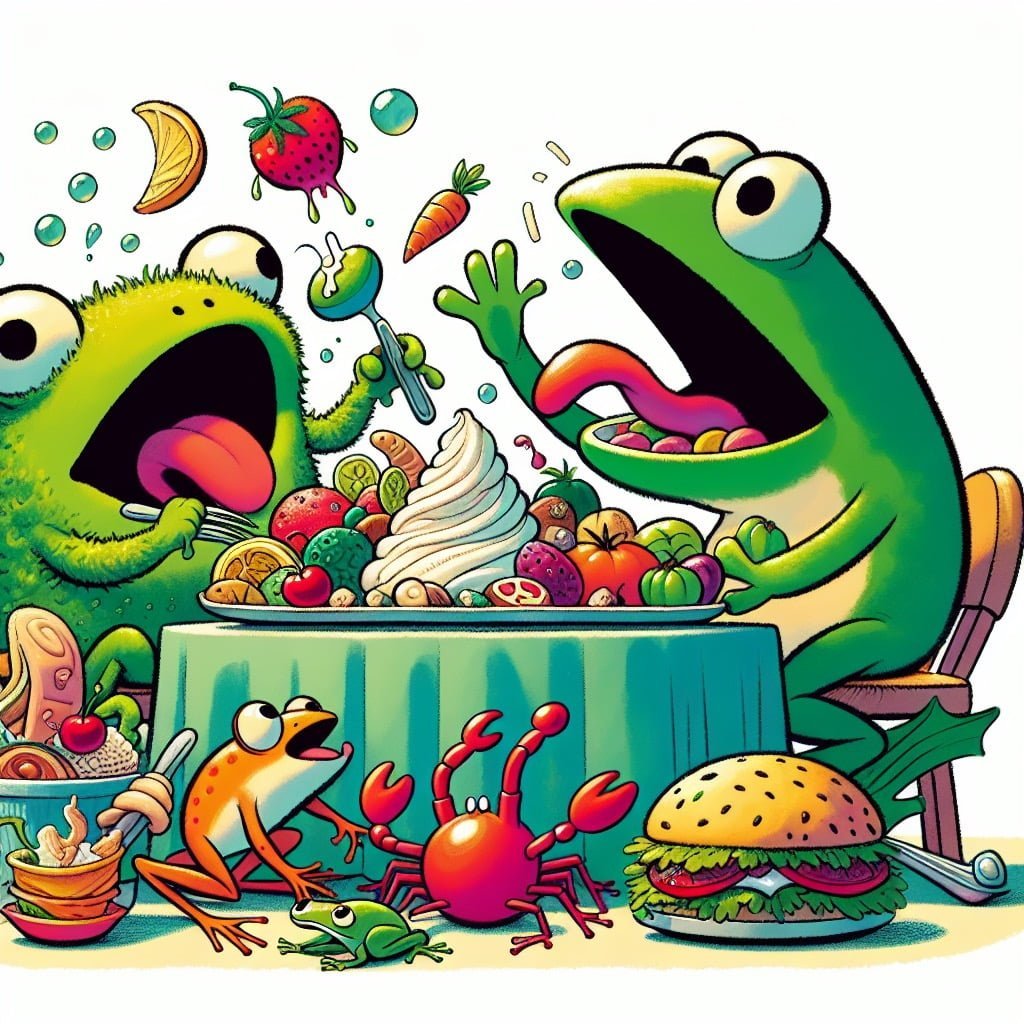Welcome to our blog post all about fascinating Frog Facts For Kids! From their unique breathing abilities to their sticky toe pads and hibernation habits, there is so much to learn about these amazing amphibians. Whether you’re a younger kid looking to discover how frogs breathe through their skin or an older kid interested in the largest frog in the world, the Goliath frog, there is something for everyone in this post. Did you know that frogs can change color to blend into their surroundings or that they play a crucial role in maintaining the ecosystem by keeping the bug population in check? Join us on this exciting journey as we dive into the incredible world of frogs and uncover ten fun facts that will leave you hopping with joy!
Frog Facts For Kids
1. Frogs Have a Unique Way of Breathing

For younger kids: Frogs can breathe through their skin and lungs.
For older kids: Frogs have a special ability to breathe through their skin, allowing them to absorb oxygen from both the air and water, giving them a dual respiratory system.
Detailed explanation:Frogs have a unique way of breathing that sets them apart from other animals. While mammals, including humans, breathe by expanding and contracting their chests to draw air into their lungs, frogs breathe through a process known as buccal pumping. This involves pulling air into their mouths with their nostrils closed, then closing their mouths and forcing the air down into their lungs by lowering the floor of their mouths. This unique method allows frogs to take in oxygen without the need for a diaphragm like mammals have.
This adaptation is well-suited to the amphibious lifestyle of frogs, as they often need to breathe in both water and air environments. When in water, frogs can also absorb oxygen through their skin, allowing them to stay submerged for extended periods of time. This is especially useful for species that live in wetlands, ponds, and streams.
Another interesting aspect of frog breathing is their ability to exchange gases through their skin. This means that even when their mouths are closed, frogs can still take in oxygen and release carbon dioxide through their skin, making respiration more efficient.
In conclusion, the unique way in which frogs breathe, through buccal pumping and skin respiration, is a fascinating adaptation that allows them to thrive in both aquatic and terrestrial environments. By understanding this aspect of frog biology, we can gain a greater appreciation for these remarkable amphibians. Kids, in particular, can learn a lot from studying Frog Facts For Kids and their amazing respiratory system.
Frog Facts For Kids
2. Some Frogs Can Change Color

For younger kids: Some frogs can change their color to blend in with their surroundings.
For older kids: Certain species of frogs, like the chameleon tree frog, can change their skin color based on their environment for camouflage and to regulate body temperature.
Detailed explanation:Frog Facts For Kids are always fascinating to learn about, and one interesting fact about frogs is that some species have the ability to change color. This phenomenon, known as physiological color change, is a remarkable trait that allows certain frogs to blend in with their surroundings or communicate with other frogs.
There are several reasons why frogs may change color. One common reason is for camouflage, which helps them avoid predators or sneak up on prey. For example, a frog living in a green leafy environment may change its skin color to match the leaves, making it nearly invisible to predators. This ability to adapt their color to match their surroundings is crucial for the survival of these frogs in the wild.
Another reason why some frogs change color is for social signaling. Frogs use color changes as a way to communicate with other frogs during courtship rituals or territorial disputes. By altering their skin color, frogs can convey messages to potential mates or rivals, helping them establish dominance or attract a mate.
It is important to note that not all frog species have the ability to change color. Those that do typically have specialized cells in their skin called chromatophores, which contain pigments that can expand or contract to alter the frog’s color. The process of changing color is controlled by hormones, environmental factors, and the frog’s own nervous system.
In conclusion, the ability of some frogs to change color is a fascinating adaptation that serves a variety of important purposes in their natural habitats. Studying this phenomenon not only provides insight into the behavior of these amazing creatures, but also highlights the incredible diversity and complexity of the animal kingdom. Learning about Frog Facts For Kids is not only educational, but also a fun way to appreciate the wonders of the natural world.
Frog Facts For Kids
3. A Group of Frogs is Called an Army

For younger kids: A bunch of frogs together is called an army!
For older kids: When you see a large group of frogs congregating, you’re witnessing an ‘army’ of frogs, a term used as a collective noun for these amphibians.
Detailed explanation:One fascinating fact about frogs that is sure to catch the attention of children is that a group of frogs is actually called an army. This quirky term for a gathering of these amphibians conjures up images of a battalion of soldiers hopping around together, which can make learning about frogs all the more exciting for kids.
When children hear that a group of frogs is called an army, it piques their curiosity and encourages them to learn more about these fascinating creatures. This interesting tidbit not only engages young minds but also helps them remember and retain information about frogs in a fun and memorable way.
Exploring the behavior of frogs in groups, or armies, can also provide valuable insight into their social dynamics and interactions. For example, children can learn that frogs may gather together for protection, to hunt for food, or to call out to potential mates. Understanding how frogs interact with one another in a group setting adds another layer of complexity to these creatures and fosters a deeper appreciation for the natural world.
By incorporating fun and intriguing facts like the term “army” for a group of frogs into educational materials, educators and parents can make learning about these amphibians more engaging and accessible for children. This kind of approach not only makes learning fun but also helps to instill a lifelong love of science and nature in young minds. So next time you see a group of frogs hopping around, remember that you’re witnessing an army in action!
Frog Facts For Kids
4. Frogs Have Sticky Toe Pads

For younger kids: Frogs can stick to surfaces with their sticky toes.
For older kids: The unique toe pads of frogs secrete mucous that helps them cling to various surfaces and climb trees, enabling them to jump and move swiftly in their habitats.
Detailed explanation:Frogs are fascinating amphibians that have many unique adaptations to help them thrive in their environment. One of the most interesting features of frogs is their sticky toe pads, which allow them to climb and cling to various surfaces.
These toe pads, also known as adhesive pads, are covered in small, microscopic structures called papillae. These papillae create a large surface area that allows frogs to create a strong grip on surfaces such as trees, rocks, and even glass. This adaptation is crucial for frogs, as it helps them to move efficiently in their habitats, whether they are climbing trees or clinging to rocks near water bodies.
The sticky toe pads of frogs are especially important for their hunting and defense mechanisms. Frogs use their toe pads to catch prey by quickly jumping and sticking to insects or other small animals. This allows them to be successful hunters and feed on a variety of organisms in their ecosystem. Additionally, the toe pads help frogs to escape from predators by quickly climbing to safety out of reach.
In conclusion, the sticky toe pads of frogs are a remarkable adaptation that allows these amphibians to navigate their surroundings with ease. Whether they are climbing trees, catching prey, or escaping from predators, the adhesive pads play a crucial role in the life of a frog. As we learn more about these fascinating creatures, we gain a greater appreciation for the unique adaptations that help them survive in the wild. These **Frog Facts For Kids** can inspire curiosity and wonder about the natural world around us.
Frog Facts For Kids
5. Frogs Swallow Their Food Whole

For younger kids: Frogs gulp down their food without chewing it!
For older kids: Frogs lack teeth, so they swallow their prey whole, relying on their powerful jaws to quickly consume insects, small fish, and other creatures.
Detailed explanation:Frogs are fascinating creatures with unique feeding habits. One interesting frog fact for kids to learn about is that frogs swallow their food whole. Unlike humans and many other animals that chew their food before swallowing, frogs do not have teeth for chewing. Instead, they use their powerful jaws to catch prey and swallow it whole.
When a frog spots food, such as insects, small fish, or even other frogs, it will rapidly extend its sticky tongue to catch the prey. The prey is then quickly pulled back into the frog’s mouth. Frogs have a specialized organ called the buccal cavity that helps them to push the food down into their stomach. This process allows frogs to consume large prey items that might not fit through their narrow throats if chewed.
Swallowing food whole has advantages for frogs in terms of energy efficiency. By not wasting energy on chewing, frogs can quickly consume their food and move on to hunting more prey. This feeding strategy also helps frogs to avoid losing valuable nutrients that might be lost during the chewing process.
In addition to swallowing their food whole, frogs have other interesting adaptations to help them thrive in their environment. For example, some frogs have long, sticky tongues to catch fast-moving prey, while others have strong jaws to capture larger animals. Learning about these fascinating frog facts can help kids appreciate the diversity and adaptability of these amazing amphibians. So next time you see a frog catching its dinner, remember that it’s all part of their unique feeding behavior. Frog Facts For Kids are truly fascinating!
Frog Facts For Kids
6. The Goliath Frog is the Largest Frog in the World

For younger kids: The Goliath frog can grow as big as a small dog!
For older kids: The Goliath frog, found in West Africa, is the largest frog species globally, with some individuals reaching lengths of over a foot and weighing up to 7 pounds.
Detailed explanation:Frog Facts For Kids: The Goliath Frog, scientifically known as Conraua goliath, holds the title of being the largest frog in the world. This impressive amphibian can grow up to 12.5 inches in length and weigh up to 7.2 pounds. Found in the rainforests of Equatorial Guinea and Cameroon in Africa, the Goliath Frog’s massive size is attributed to its habitat and the abundance of food sources available to them.
One fascinating fact about the Goliath Frog is its unique diet, which consists mainly of insects, crustaceans, and occasionally small fish. This diet, combined with their large size, allows them to thrive in their natural environment and maintain their impressive stature.
The Goliath Frog’s size also plays a role in its reproduction process. Unlike many other frog species, the Goliath Frog does not lay hundreds of eggs at a time. Instead, they lay relatively few eggs, typically around 30, which are then guarded by the male frog. This parenting behavior is crucial for the survival of the offspring, as it provides them with protection and increases their chances of reaching maturity.
Unfortunately, the Goliath Frog is currently listed as endangered due to habitat loss, pollution, and over-harvesting for the pet trade. Conservation efforts are in place to protect these incredible creatures and ensure their survival for future generations to appreciate. By raising awareness about the Goliath Frog and other endangered species, we can work towards preserving their habitats and ultimately saving them from extinction.
Frog Facts For Kids
7. Frogs Play an Important Role in the Ecosystem

For younger kids: Frogs help keep the bug population in check.
For older kids: Frogs act as natural pest control by eating insects like mosquitoes and flies, playing a crucial role in maintaining ecological balance in their habitats.
Detailed explanation:Frog Facts For Kids: Frogs play an essential role in maintaining the balance of ecosystems around the world. These amphibians are considered keystone species, meaning they have a disproportionately large impact on their environment compared to their abundance.
One of the key ways in which frogs contribute to the ecosystem is by controlling insect populations. Frogs are voracious predators, feeding on a variety of insects such as mosquitoes, flies, and beetles. By keeping insect populations in check, frogs help to prevent outbreaks of pests that can damage crops and spread disease. This natural form of pest control is not only beneficial for humans but also for other species within the ecosystem.
Furthermore, frogs are an important food source for a wide range of predators, including birds, snakes, and mammals. By serving as prey, frogs help to support the populations of these other animals. In turn, these predators play their own roles in the ecosystem, contributing to the balance of the food web.
Additionally, frogs are indicators of environmental health. Due to their permeable skin that allows for the absorption of water and oxygen, frogs are particularly sensitive to changes in their environment. Factors such as pollution, habitat destruction, and climate change can impact frog populations. Monitoring the health of frog populations can provide valuable insights into the overall health of an ecosystem.
In conclusion, frogs are integral to the health and functioning of ecosystems. By consuming insects, serving as prey, and acting as indicators of environmental health, frogs play a crucial role in maintaining the delicate balance of nature. Their presence is essential for the well-being of the ecosystem as a whole.
Frog Facts For Kids
8. Frogs Hibernate in the Winter

For younger kids: Frogs sleep in cozy places during the cold winter months.
For older kids: Many frog species enter a state of dormancy called hibernation during winter, where they slow down their metabolism to survive the cold temperatures until spring arrives.
Detailed explanation:Frogs are fascinating creatures that exhibit a unique behavior during the cold winter months – hibernation. This process of hibernation is crucial for frogs to survive the harsh conditions of winter when food sources are scarce and temperatures drop significantly.
During hibernation, frogs enter a state of dormancy where their metabolic rate decreases, allowing them to conserve energy. They typically find a suitable hiding spot such as burrows in the ground, under leaf litter, or at the bottom of ponds to spend the winter months. Frogs have a remarkable ability to withstand freezing temperatures by producing a type of antifreeze in their blood that prevents ice crystals from forming and damaging their cells.
For kids interested in frog facts, it’s important to understand that hibernation is a natural and essential survival mechanism for these amphibians. It helps them conserve energy and stay protected from predators during the winter season. Once the temperatures start to warm up in the spring, frogs will slowly emerge from their hibernation sites and resume their normal activities.
Learning about frog hibernation can be a fun and educational experience for kids, as it highlights the incredible adaptations that animals have developed to survive in different environments. By understanding how frogs hibernate, kids can gain a deeper appreciation for the natural world and the diverse ways in which animals have evolved to thrive in their habitats. So, next time you see a frog hopping around in the spring, remember that it may have been hibernating just a few weeks ago to survive the winter.
In conclusion, frog hibernation is a fascinating aspect of their biology that showcases their remarkable ability to adapt to changing environmental conditions. Kids interested in frog facts can learn a lot from studying this unique behavior.
Frog Facts For Kids
9. Frogs Have Unique Tasting Abilities

For younger kids: Frogs use their sticky tongues to catch insects for a tasty meal.
For older kids: Frogs have an extraordinary sense of taste due to their vomerine teeth and a specialized tongue that can retract quickly to catch insects and bring them back into their mouths.
Detailed explanation:Frogs have unique tasting abilities that differ from those of humans and many other animals. Their sense of taste is closely linked to their survival instincts and dietary habits.
Frogs use their sense of taste primarily to distinguish between edible and inedible foods. They have taste buds not only on their tongues, but also on the roofs of their mouths. This allows them to quickly assess the taste of potential prey or food items.
One interesting aspect of frog tasting abilities is their ability to detect chemical cues in their environment. Frogs are known to have a specialized sense of taste that allows them to detect and respond to different chemical compounds in water or on land. This is particularly important for frogs that rely on hunting for their food, such as insect-eating species.
Another fascinating aspect of frog tasting abilities is their ability to distinguish between different types of prey based on taste. For example, some frogs are known to have a preference for certain insects over others, which may be related to their nutritional needs or digestive abilities.
Overall, the unique tasting abilities of frogs play a key role in their survival and adaptation to their environments. By being able to quickly assess and respond to different tastes and chemical cues, frogs are better equipped to find and consume the food they need to thrive. This makes their sense of taste a fascinating aspect of their biology and behavior.
In conclusion, frogs have unique tasting abilities that are essential for their survival and dietary habits. Their specialized taste buds and ability to detect chemical cues help them distinguish between edible and inedible foods, as well as between different types of prey. This fascinating aspect of frog biology adds to the complexity of these amazing creatures.
Frog Facts For Kids
10. Some Frogs Are Poisonous

For younger kids: Some frogs have bright colors to warn others that they’re poisonous.
For older kids: Certain frog species like the poison dart frog produce toxins in their skin as a defense mechanism, showcasing vibrant colors to warn predators to stay away due to their poisonous nature.
Detailed explanation:One fascinating aspect of frogs that captivates the interest of many kids is their ability to produce toxins that can be harmful or even deadly to predators. This defense mechanism is known as being poisonous, and it serves as a form of protection for the frog against being eaten by other animals. It is important for kids to understand that not all frogs are poisonous, but some species have developed this trait as a survival strategy.
One of the most well-known poisonous frogs is the poison dart frog, which is native to Central and South America. These brightly colored frogs secrete toxins through their skin, and their bright colors serve as a warning to potential predators to stay away. In fact, some species of poison dart frogs are so toxic that even touching them can be dangerous. This is why it is crucial for kids to admire frogs from a safe distance and never attempt to handle them without proper guidance and supervision.
Teaching kids about the concept of frogs being poisonous can also be a great way to introduce them to the importance of biodiversity and the delicate balance of ecosystems. By understanding the role that poisonous frogs play in their natural habitat, kids can develop a deeper appreciation for the complexity and beauty of the natural world. Additionally, learning about poisonous frogs can help kids make connections between the animal kingdom and their own lives, fostering a sense of curiosity and respect for the environment.
In conclusion, the fact that some frogs are poisonous is a captivating aspect of frog ecology that can spark the curiosity and imagination of kids. By exploring this topic further, kids can gain a greater understanding of the diverse adaptations that frogs have developed to survive in their environments. Frog Facts For Kids are not only informative but also help to inspire a sense of wonder and appreciation for the amazing creatures that inhabit our planet.
Did you know?
Did you know that some frogs can jump up to 20 times their body length in a single leap?
Summary of Frog Facts For Kids
If you’re looking for fascinating facts to spark your child’s curiosity about nature, this blog post on frog facts for kids is a must-read! From learning about how frogs breathe through their skin and lungs to discovering how some frogs can change color for camouflage, each tidbit is sure to captivate young minds. Did you know that a group of frogs is called an army, or that frogs swallow their food whole? And have you ever heard of the Goliath frog, the largest frog species in the world? These fun facts shed light on the unique characteristics and behaviors of our amphibian friends while highlighting their important role in the ecosystem. Whether your child is a budding biologist or simply loves animals, this blog post is filled with engaging information that will leave them wanting to learn more about the wonderful world of frogs!
Sources and additional information for Frog Facts For Kids
WikipediaBritannicaSan Diego Zoo KidsThe Smithsonian InstitutionDK Find Out!Australian MuseumWorld Wildlife FundThe Nature ConservancyAnimal PlanetMonterey Bay AquariumPBS NatureSmithsonian’s National Zoo & Conservation Biology InstituteWorld Wildlife FundAnimal Diversity Web (University of Michigan)IUCN Red List of Threatened SpeciesThe Cornell Lab of Ornithology – All About BirdsNational Audubon SocietyEncyclopedia of LifeSeaWorld Parks & EntertainmentAustralian Museum – AnimalsEncyclopedia of Life




